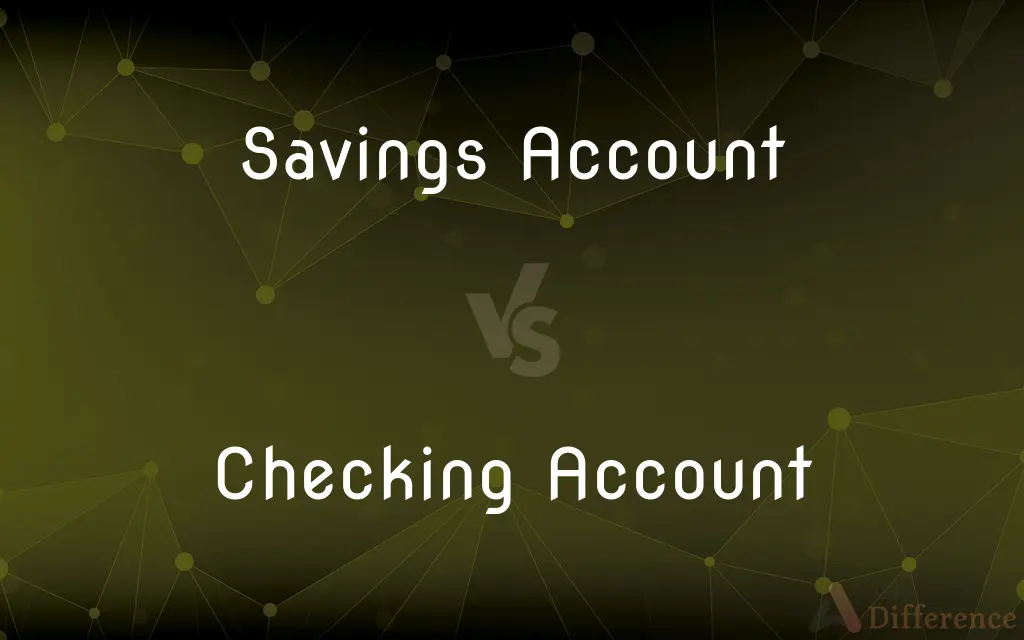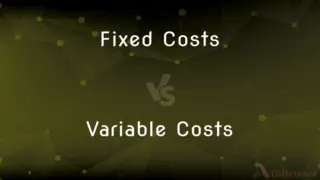Savings Account vs. Checking Account — What's the Difference?
By Tayyaba Rehman — Published on September 26, 2023
A savings account is primarily for saving money and earning interest, while a checking account is designed for regular transactions like bill payments and purchases.

Difference Between Savings Account and Checking Account
Table of Contents
ADVERTISEMENT
Key Differences
A savings account is a financial tool designed for individuals to save money over a period, typically with the added benefit of accruing interest. In contrast, a checking account is more transactional, allowing users to deposit and withdraw funds regularly.
Most banks place restrictions on the number of transactions you can make from a savings account within a certain period. On the other hand, checking accounts are structured to accommodate frequent transactions, making them suitable for everyday financial activities.
Interest rates are a distinguishing feature: savings accounts generally offer interest on the account balance, encouraging long-term saving. Conversely, checking accounts might not offer interest, or if they do, it's usually at a lower rate.
Overdraft protection is another point of differentiation. While some checking accounts provide this feature, allowing users to spend slightly more than the account balance, savings accounts typically do not offer this service.
Fees associated with the two accounts can vary. Savings accounts might charge fees if the balance falls below a certain minimum or if there are too many transactions. In contrast, checking accounts may have monthly maintenance fees, ATM fees, or fees for checks.
ADVERTISEMENT
Comparison Chart
Primary Purpose
Save money and earn interest.
Regular transactions like bill payments and purchases.
Transaction Limits
Typically has a limit on withdrawals.
Designed for frequent transactions with few limits.
Interest
Generally offers interest on deposits.
Might not offer interest or offers at a lower rate.
Overdraft Protection
Rarely offers overdraft protection.
Often provides overdraft protection for account holders.
Fees
May charge for excessive transactions or low balances.
May have monthly fees, ATM fees, or check-related fees.
Compare with Definitions
Savings Account
A financial account promoting long-term deposits and earning interest.
It's wise to have a savings account for unexpected expenses.
Checking Account
An account allowing regular access and usage without many restrictions.
Businesses often have a separate checking account for operations.
Savings Account
A bank account designed to accumulate and save money.
She deposited her bonus into her savings account to earn interest.
Checking Account
An account used for depositing and withdrawing funds frequently.
She transferred money from her checking account to pay rent.
Savings Account
An account where funds are saved for future use and earn interest.
His savings account has grown significantly over the years.
Checking Account
A transactional bank account for everyday spending and bill payments.
It's convenient to have a debit card linked to a checking account.
Savings Account
An account in a bank primarily meant for holding savings.
Transferring money from a savings account often has limits.
Checking Account
A primary banking tool for managing day-to-day finances.
He noticed unauthorized transactions in his checking account and alerted the bank.
Savings Account
A deposit account earning interest over time.
She checks her savings account balance every month to monitor growth.
Checking Account
A bank account designed for daily financial transactions.
He pays his bills directly from his checking account.
Common Curiosities
Can I write checks from my Savings Account?
Typically, no. You write checks from a Checking Account, while Savings Accounts are mainly for storing money.
Is there a limit to how many transactions I can make with my Savings Account?
Yes, Savings Accounts usually have monthly transaction limits, while Checking Accounts offer more flexibility in transactions.
Which account is better for daily expenses?
A Checking Account is designed for daily expenses, allowing easy access and transactions, whereas a Savings Account is more for accumulation.
What's the primary purpose of a Savings Account?
A Savings Account is designed for depositing and accumulating money, often with interest, while a Checking Account facilitates daily transactions.
Are both accounts FDIC insured?
Yes, both Savings and Checking Accounts are generally FDIC insured up to applicable limits, ensuring safety for deposited funds.
Are there fees associated with these accounts?
Both Savings and Checking Accounts might have fees, such as for low balances or overdrafts, but specifics vary by bank.
Which account usually offers higher interest rates?
Savings Accounts often have higher interest rates than Checking Accounts, encouraging longer-term deposits.
Can I set up direct deposit for my paycheck into a Savings Account?
While possible, most people choose to direct deposit paychecks into Checking Accounts and transfer portions to Savings as desired.
Do both accounts come with online banking features?
Typically, yes. Both Savings and Checking Accounts usually offer online banking capabilities for easy management.
Can I earn interest with my Checking Account?
Some Checking Accounts do offer interest, but rates are typically lower than Savings Accounts. Always check the terms of your specific account.
Can I access both accounts with a single ATM card?
Often, banks offer ATM cards that can access both Checking and Savings Accounts, but always check with your institution.
Do all Checking Accounts come with checkbooks?
Most Checking Accounts offer checkbooks, but always verify with your bank, especially as digital banking grows.
Can I have both accounts at different banks?
Absolutely. You can have a Savings Account at one bank and a Checking Account at another, or both at the same institution.
Which account is typically used for setting up automatic bill payments?
Checking Accounts are usually used for automatic bill payments due to their transactional nature.
Is it possible to transfer money between my Checking and Savings Accounts?
Yes, most banks allow easy transfers between your Checking and Savings Accounts.
Share Your Discovery

Previous Comparison
Chrystal vs. Crystal
Next Comparison
Fixed Costs vs. Variable CostsAuthor Spotlight
Written by
Tayyaba RehmanTayyaba Rehman is a distinguished writer, currently serving as a primary contributor to askdifference.com. As a researcher in semantics and etymology, Tayyaba's passion for the complexity of languages and their distinctions has found a perfect home on the platform. Tayyaba delves into the intricacies of language, distinguishing between commonly confused words and phrases, thereby providing clarity for readers worldwide.
















































